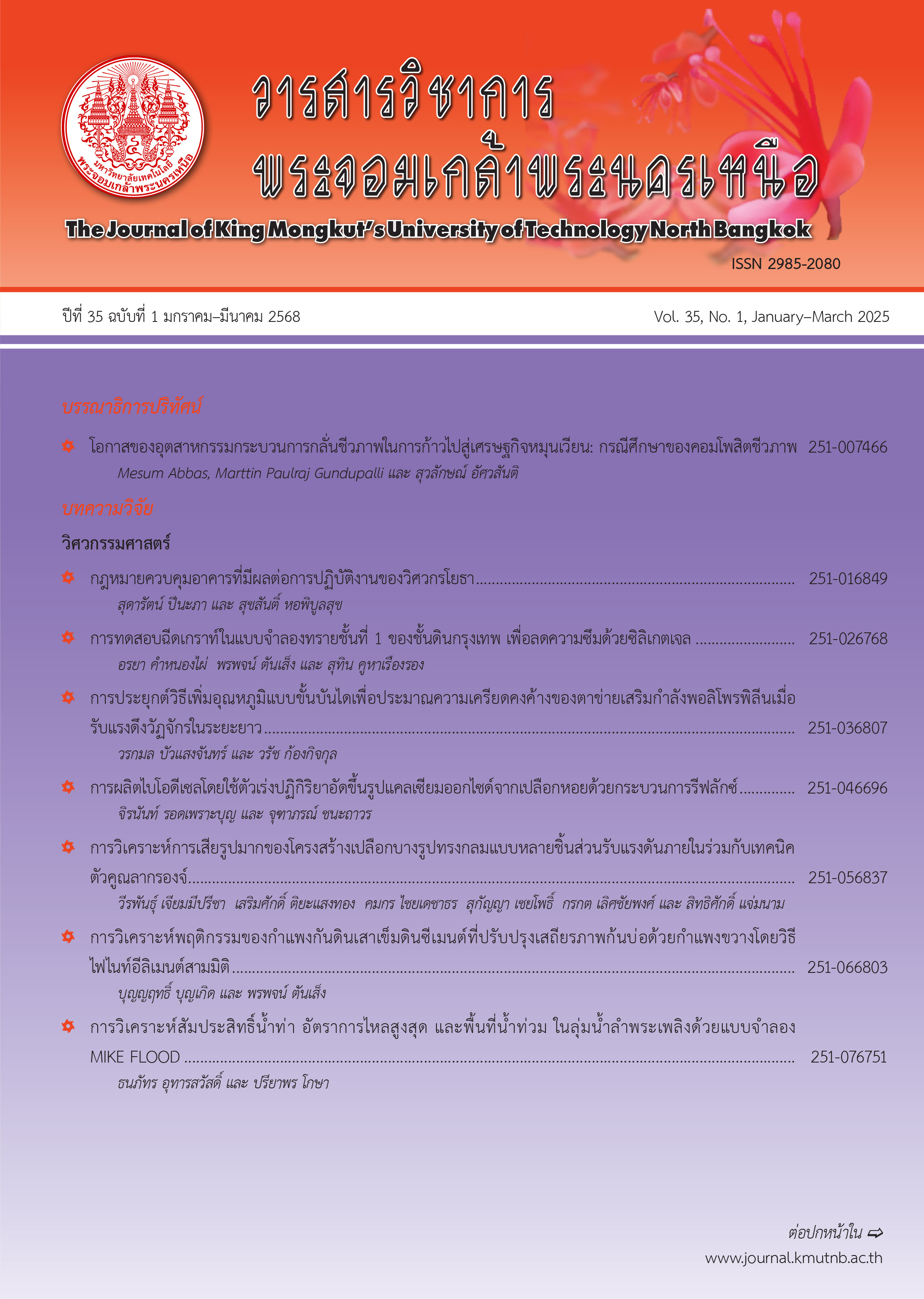ค่าความยาวรันเฉลี่ยโดยสมการปริพันธ์เชิงตัวเลขสำหรับแผนภูมิควบคุมค่าเฉลี่ยเคลื่อนที่ ถ่วงน้ำหนักแบบเลขชี้กำลังดัดแปลงสำหรับตัวแบบถดถอยในตัวกำลังสอง
Main Article Content
บทคัดย่อ
การวิจัยนี้ศึกษาวิธีการประมาณค่าความยาวรันเฉลี่ย (Average Run Length; ARL) โดยวิธีสมการปริพันธ์เชิงตัวเลข (Numerical Integral Equation; NIE) ได้แก่ วิธีกฎเกาส์ (Gaussian Rule) วิธีกฎค่ากลาง (Midpoint Rule) วิธีกฎสี่เหลี่ยมคางหมู (Trapezoidal Rule) และวิธีกฎของซิมป์สัน (Simpson’s Rule) สำหรับแผนภูมิควบคุมค่าเฉลี่ยเคลื่อนที่ถ่วงน้ำหนักแบบเลขชี้กำลังดัดแปลง (Modified Exponentially Weighted Moving Average Control Chart; Modified EWMA) สำหรับตัวแบบถดถอยในตัวกำลังสอง เมื่อความคลาดเคลื่อนมีการแจกแจงแบบเลขชี้กำลัง นอกจากนี้ ได้ทำการเปรียบเทียบประสิทธิภาพแผนภูมิควบคุมค่าเฉลี่ยเคลื่อนที่ถ่วงน้ำหนักแบบเลขชี้กำลังดัดแปลง (Modified Exponentially Weighted Moving Average Control Chart; Modified EWMA) และแผนภูมิควบคุมค่าเฉลี่ยเคลื่อนที่ถ่วงน้ำหนักแบบเลขชี้กำลัง(Exponentially Weighted Moving Average Control Chart; EWMA) โดยเกณฑ์การวัดประสิทธิภาพของแผนภูมิควบคุม คือ ค่าความยาวรันเฉลี่ยเมื่อกระบวนการไม่อยู่ภายใต้การควบคุม (Out-of-Control Average Run Length; ARL1) และเวลาที่ใช้ในการประมวลผลของวิธีสมการปริพันธ์เชิงตัวเลข (CPU Times) จากผลการวิจัยพบว่า ค่าความยาวรันเฉลี่ยโดยวิธีสมการปริพันธ์เชิงตัวเลขทั้ง 4 วิธีให้ค่าใกล้เคียงกัน และเมื่อศึกษาประสิทธิภาพของแผนภูมิควบคุมพบว่า แผนภูมิควบคุม Modified EWMA มีประสิทธิภาพในการตรวจจับการเปลี่ยนแปลงค่าเฉลี่ยของกระบวนการได้ดีกว่าแผนภูมิควบคุม EWMA ในทุกระดับการเปลี่ยนแปลง นอกจากนี้ยังได้นำค่าประมาณ ARL โดยวิธีสมการปริพันธ์เชิงตัวเลขไปประยุกต์ใช้กับข้อมูลจริงอีกด้วย
Article Details

อนุญาตภายใต้เงื่อนไข Creative Commons Attribution-NonCommercial-NoDerivatives 4.0 International License.
บทความที่ลงตีพิมพ์เป็นข้อคิดเห็นของผู้เขียนเท่านั้น
ผู้เขียนจะต้องเป็นผู้รับผิดชอบต่อผลทางกฎหมายใดๆ ที่อาจเกิดขึ้นจากบทความนั้น
เอกสารอ้างอิง
W. A. Shewhart, Economic control of quality of manufactured product, Martino Fine Books 2015 Reprint of 1931.
S. W. Roberts, “control chart test based on geometric moving average,” Technometrics, vol. 1, no. 3, pp. 239–250, 1959.
A. K. Patel and J. Divecha, “Modified exponentially weighted moving average (EWMA) control chart for an analytical process data,” Journal of Chemical Engineering and Materials Science, vol. 2, no. 1, pp. 12–20, 2011.
N. Khan, M. Aslam, and C. Jun, “Design of a control chart using a modified EWMA statistic,” Quality and Reliability Engineering International, vol. 33, pp. 100–114, 2017.
C. Sangaroonwong, Y. Areepong, and S. Sukparungsee, “Average Run Length by Numerical Integral Equation Approach of Modified EWMA control chart when Observations are from Continuous Distributions,” Global Goals, Local Actions: Looking Back and Moving Forward 2020 (in Thai).
S. Haider, “Forecasting Dhaka Stock Exchange (DSE) return: An Autoregressive Integrated Moving Average (ARIMA) Approach,” North South Business Review, vol. 3, no 1, July 2009.
P. Phanthuna, Y. Areepong, and S. Sukparungsee, “Numerical integral equation methods of average run length on modified ewma control chart for exponential AR(1) process,” IMECS 2018, vol 2, Hong Kong, HK, 2018, pp. 845–847.
K. Karoon, Y. Areepong, and S. Sukparungsee, “Numerical integral equation methods of average run length on extended ewma control chart for autoregressive process,” in Proceedings of the World Congress on Engineering 2021, WCE 2021, July 7–9, 2021.
C. W. Champ and S. E. Rigdon, “A comparison of the Markov chain and the integral equation Approaches for evaluating the run length distribution of quality control charts,” Communications in Statistics - Simulation and Computation, vol. 20, no.1, pp. 191–204, 1991.
Historical data PM2.5. (2022) “Pollution Control Department,” 2022. [Online] (in Thai). Available: http://air4thai.pcd.go.th/webV2/history/ pm25_2011_2020.zip

